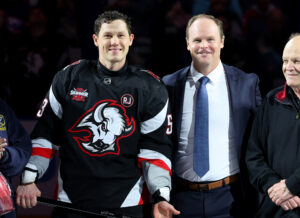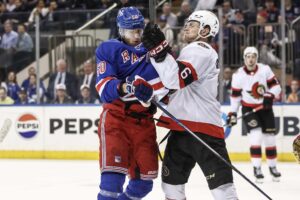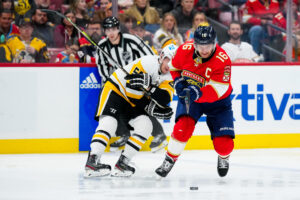There are lots of Pittsburgh Penguins analysis this week as they have given us many storylines to talk about just a few weeks into this brand new season. Today, we examine three observations from the Penguins play thus far and how they will impact the future performances of this roster. What have we learned about this Pittsburgh Penguins team after eight games?
After Eight: Pittsburgh Penguins Analysis
Winning this Way is Unsustainable
The Pittsburgh Penguins are currently sporting a respectable 4-3-1 record and sit in fourth place in the East Division. They have had to perform incredible comebacks just to force extra time. Only eight games into the 2021 NHL season, the Penguins have played bonus hockey in half of them. Pittsburgh has had to participate in four overtimes, two of which went to a shootout. The Pens have been fortunate thus far, with a 1-1 record in overtime and a 2-0 record in shootouts. Although they’ve fallen behind and trailed for a vast majority of each game so far, they have fought back valiantly, winning crucial points in the process.
The Penguins have gotten their share of lucky breaks as well. It’s more than fair to say that without them, they may be further down in the standings. Just ask Jared McCann about lucky bounces leading to flukey goals which end 20 game plus goalless droughts. The Penguins have been very fortunate with lucky bounces late in games but cannot rely on those. They cannot afford to start slow and be forced to come back from multiple goals down against good defensive teams like the Philadelphia Flyers, New York Islanders, and Boston Bruins.
Consistency Needed
The Penguins have not played a full sixty minutes to date. They have not been “hard to play against” consistently enough. There has been a good period here or there but have rarely had sustained pressure against the opposition. Has there been a period where all four lines were going strong? Nothing springs to mind. This roster has had times when they showed pushback and determination, but those have unfortunately been few and far between. Penguins Head Coach Mike Sullivan loves to roll four lines but can only do so when the level of play is consistent across the board.
Defence and Goaltending are the X-Factor
For the first time in almost 18 years, the Pittsburgh Penguins enter a season without one of Marc-Andre Fleury or Matt Murray as their starting goalie. After trading away two-time Stanley Cup Champion Murray, the Penguins have clearly given 25-year-old Tristan Jarry the crease. The question looming large that has been asked for the last season plus is still unanswered. Is Tristan Jarry a bonafide starting goalie in the NHL? The Penguins obviously think he is, dishing him a three-year, 10.5 million dollar contract this offseason. While Casey DeSmith has been a competent NHL backup for parts of two seasons, he does not have the established track record. He is nowhere near being the Penguins own Anton Khudobin. Many teams wish they had a solid safety net in the form of veteran backup.
So far this season, the Penguins have received below-average goaltending overall, but have received timely stops when needed. No thanks to the leaky and oft-injured defence core. Tristan Jarry at five-on-five possesses a very unimpressive .874 Save Percentage and has served up some juicy rebounds which turned into easy tap-in goals. A 3.92 GAA and -6.92 Goals saved above average are simply not acceptable, albeit in a small sample size. The Pittsburgh Penguins simply must receive solid goaltending if they have any shot at winning their first playoff series since 2018.
Survival Mode Enabled
Now, the team is faced with potentially only one healthy, NHL regular starting on defence for possibly weeks. It’s now or never. The Penguins need to commit to structured play and backchecking as a team. Clearing the front of the net and picking up opposing players in the slot would help too. As much as some disliked the Jack Johnson’s and Erik Gudbranson’s of the world, they cleared the front of the net and helped out their goalies in that regard. Now did they turn the puck over in the defensive zone, ruins smooth transitions to offence, and force the goalies to face more high-danger shots? Let’s leave that one alone for now and just pray that the Penguins can get a couple of defensemen back from injury in the next couple of weeks, preferably the top-four types.
What is not wrong with the Power Play right now?
Let’s answer that question with another question. What are the positives about the power play? Maybe the fact that the second unit actually shoots the puck every once in a while. Let’s face it. The Pittsburgh Penguins need a total and complete overhaul of their power play. New penguins Assistant Coach Todd Rierden has a huge job in front of him.
Although they have converted 18.52 percent of their opportunities into goals, most of them have not been because the power play was fluid or set up a crisp play. Sometimes it seems they get goals almost by accident on broken plays or flukey bounces. It’s the same story from last year, minus trying to jam a left-handed shot on the left half wall.
Watching dynamic power plays zip the puck around is both exciting and depressing. The Penguins power play has no movement outside the occasional outside pass. They need to cycle the puck around quickly and have players constantly on the move. Phil Kessel is gone, but the Pens stars still want to tic-tac-toe around the outside. For once, the crazed fan in section 117 screaming, “SHOOT!” is not wrong.
They need to shoot more and crash the net for rebounds. A top unit consisting of Sidney Crosby, Evgeni Malkin, Jake Guentzel, Bryan Rust, and Kris Letang on paper looks like one of the most skilled units in the NHL. But something substantial is missing. The Penguins power play does not generate any momentum, even when a puck goes in.
The Fix
Is it time to break up the power play core three? Desperate times call for desperate measures. It needs to stop being about who has “earned” top unit time because of what they have done for their whole career and start being about who will will benefit this team’s play right now. The Penguins need to get back to “Basic Power Play Strategies 101”. Move the puck quickly. Force the penalty kill to overextend. Look for cross-seam passes or plays into the slot area if possible. Take the goalie’s eyes away. Get pucks to the net. The Penguins rank near the bottom of the league in shots on the power play, but that’s beating a dead horse. Losing Patric Hornqvist will not help the power play, but shooting the puck more will.
Main Photo:






